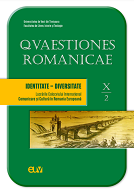La diversità tonale di Guido Cavalcanti nell’identità corale della lirica duecentesca
Guido Cavalcanti's tonal diversity within the choral identity of lyric poetry in the 13th century
Author(s): Oana SălișteanuSubject(s): 13th to 14th Centuries, Translation Studies, Identity of Collectives, Italian literature, Sociology of Literature
Published by: Universitatea de Vest din Timişoara
Keywords: Guido Cavalcanti; Romanian translation; troubadours; Dolce Stil Nuovo; Averroes;
Summary/Abstract: The recent publication of the Romanian translation of Guido Cavalcanti's complete work, made us meditate on the singularity of the poet's voice in the context of Florentine society at the end of the 13th century, as well as on the obstacles faced in the translating process. The analysis starts with the most important elements that young Dante’s friend inherited from the previous Occitanic and Sicilian lyrical tradition (poetry genres such as canzoni, tenzoni, pastorelle, sonnets and the recurrent themes and clichés, such as spring frames, courtly love, typical feudal vassalage links transferred to lady and poet relationships) and goes on with Cavalcanti’s innovations compared to the poor previous lyric tradition before him: the dramatic change of poetic tone (from the choral and graceful serenity of the troubadours and the representatives of Scuola Siciliana and Dolce Stil Nuovo to an anxious, egocentric and pessimistic tone), the surprising philosophical background inspired by Averroes’ writings, with his theory of spiriti and spiritelli as vital principle of life, and his citizen commitment and involvement in political battles. Sonnets and short excerpts of Cavalcanti’s verse in Italian and Romanian will exemplify his great poetic art that inspired Dante Gabriel Rossetti, T.S. Eliot and Ezra Pound.
Journal: Quaestiones Romanicae
- Issue Year: X/2023
- Issue No: 2
- Page Range: 352-360
- Page Count: 9
- Language: Italian

